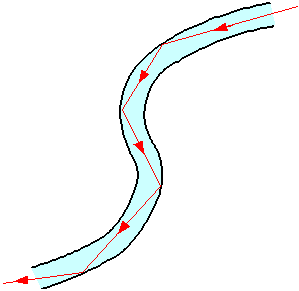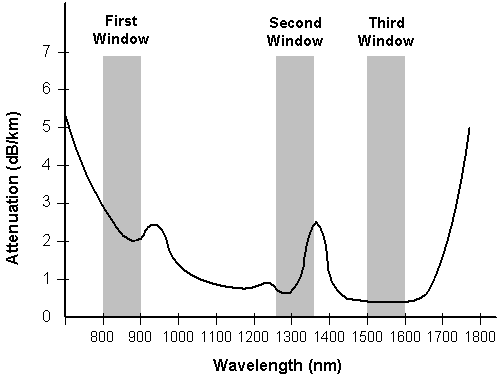Optical Fibres
For Transmitting Information by an Optical Fiber, the Information should first be converted to an Optical Signal and reconverted at the Destination, Figure 1.
 Figure 1: Light Beam Propagates through an Optical Fiber
Figure 1: Light Beam Propagates through an Optical Fiber
In practice, the Optical Signal Attenuates during Transmission over Optical Fiber. The Attenuation depends on the Wavelength of the Light Beam, Figure 2. The Transmission Windows refer to the Wavelength Regions that offer low Optical Attenuation.
 Figure 2: The Attenuation-Wavelength Curve and the Transmission Windows of an Optical Fiber
Figure 2: The Attenuation-Wavelength Curve and the Transmission Windows of an Optical Fiber
From Figure 2 and Table 1, Infrared Light with Wavelengths of 850 nm, 1,310 nm and 1,550 nm is mostly used. Therefore, the most common devices used as the Light Source in Optical Transmitters are the Light Emitting Diode (LED) and the Laser Diode (LD). They operate in the Infrared Radiation (750nm to 1mm) of the Electromagnetic Spectrum so that their Light Output is usually invisible to the human eye.
| Window Range | Operating Wavelength | |
|---|---|---|
| First Window | 800 nm – 900 nm | 850 nm |
| Second Window | 1,260 nm – 1,360 nm | 1,310 nm |
| Third Window | 1,500 nm – 1,600 nm | 1,550 nm |
Optical Fibers are replacing Copper Wires to become an important Transmission Medium. Optical Fibers offer over 1,000 times as much Bandwidth as a Copper Wire, and can support Transmission at Gigabits per second.
About CMM
Contact US
Others
Other Websites
Number of Visitors:
Last Modified Date: 10/3/2025